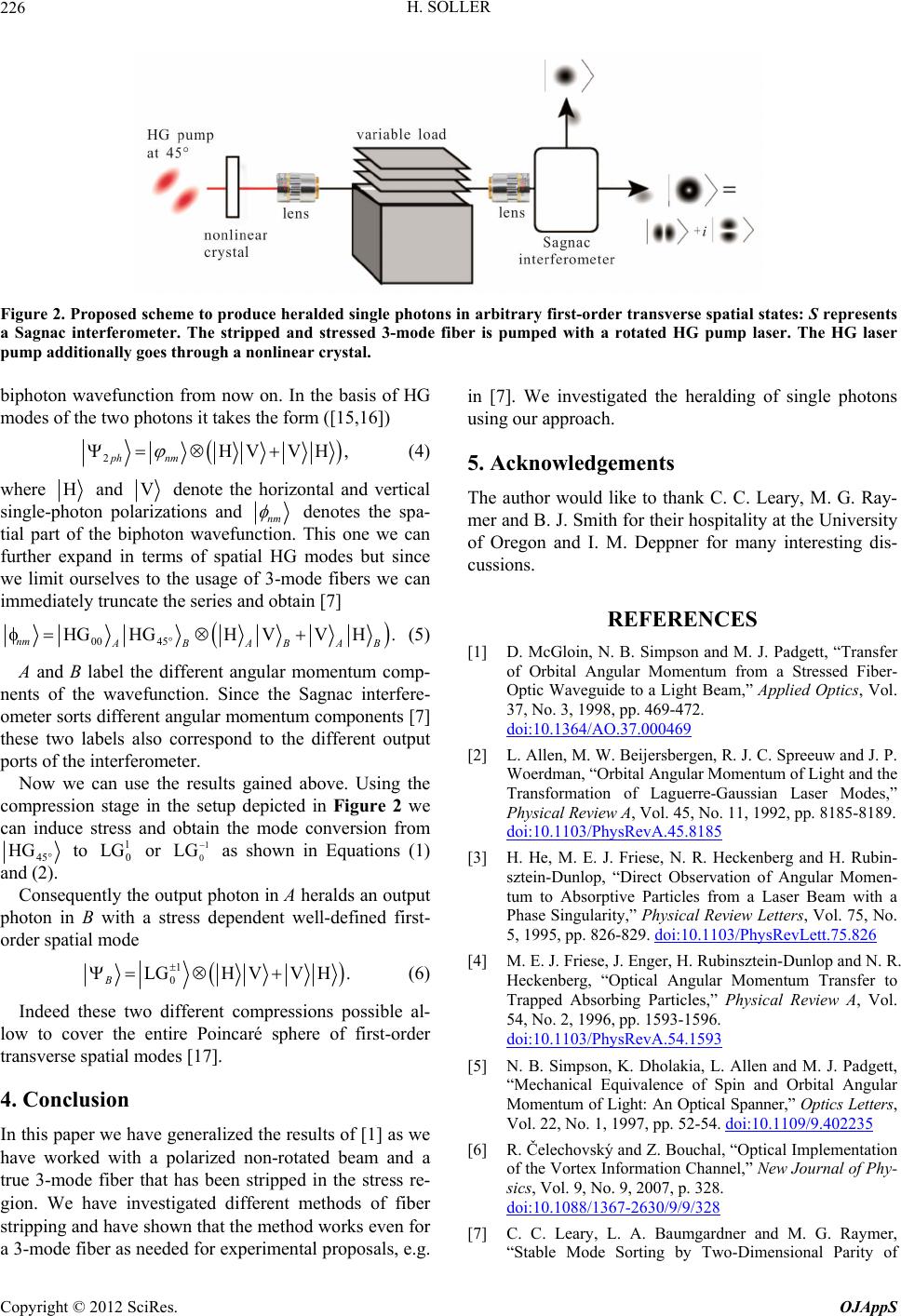
H. SOLLER
226
Figure 2. Proposed scheme to produce heralded single photons in arbitrary first-order transverse spatial states: S represents
a Sagnac interferometer. The stripped and stressed 3-mode fiber is pumped with a rotated HG pump laser. The HG laser
pump additionally goes through a nonlinear cry stal.
biphoton wavefunction from now on. In the basis of HG
modes of the two photons it takes the form ([15,16])
2HV VH,
ph nm
(4)
where H and V denote the horizontal and vertical
single-photon polarizations and nm
denotes the spa-
tial part of the biphoton wavefunction. This one we can
further expand in terms of spatial HG modes but since
we limit ourselves to the usage of 3-mode fibers we can
immediately truncate the series and obtain [7]
00 45
HG HGHV VH
nm AB ABAB
. (5)
A and B label the different angular momentum comp-
nents of the wavefunction. Since the Sagnac interfere-
ometer sorts different angular momentum components [7]
these two labels also correspond to the different output
ports of the interferometer.
Now we can use the results gained above. Using the
compression stage in the setup depicted in Figure 2 we
can induce stress and obtain the mode conversion from
45
HG to or as shown in Equations (1)
and (2).
1
0
LG 1
0
LG
Consequently the output photon in A heralds an output
photon in B with a stress dependent well-defined first-
order spatial mode
1
0
LGHVVH.
B
(6)
Indeed these two different compressions possible al-
low to cover the entire Poincaré sphere of first-order
transverse spatial modes [17].
4. Conclusion
In this paper we have generalized the results of [1] as we
have worked with a polarized non-rotated beam and a
true 3-mode fiber that has been stripped in the stress re-
gion. We have investigated different methods of fiber
stripping and have shown that the method works even for
a 3-mode fiber as needed for experimental proposals, e.g.
in [7]. We investigated the heralding of single photons
using our approach.
5. Acknowledgements
The author would like to thank C. C. Leary, M. G. Ray-
mer and B. J. Smith for their hospitality at the University
of Oregon and I. M. Deppner for many interesting dis-
cussions.
REFERENCES
[1] D. McGloin, N. B. Simpson and M. J. Padgett, “Transfer
of Orbital Angular Momentum from a Stressed Fiber-
Optic Waveguide to a Light Beam,” Applied Optics, Vol.
37, No. 3, 1998, pp. 469-472.
doi:10.1364/AO.37.000469
[2] L. Allen, M. W. Beijersbergen, R. J. C. Spreeuw and J. P.
Woerdman, “Orbital Angular Momentum of Light and the
Transformation of Laguerre-Gaussian Laser Modes,”
Physical Review A, Vol. 45, No. 11, 1992, pp. 8185-8189.
doi:10.1103/PhysRevA.45.8185
[3] H. He, M. E. J. Friese, N. R. Heckenberg and H. Rubin-
sztein-Dunlop, “Direct Observation of Angular Momen-
tum to Absorptive Particles from a Laser Beam with a
Phase Singularity,” Physical Review Letters, Vol. 75, No.
5, 1995, pp. 826-829. doi:10.1103/PhysRevLett.75.826
[4] M. E. J. Friese, J. Enger, H. Rubinsztein-Dunlop and N. R.
Heckenberg, “Optical Angular Momentum Transfer to
Trapped Absorbing Particles,” Physical Review A, Vol.
54, No. 2, 1996, pp. 1593-1596.
doi:10.1103/PhysRevA.54.1593
[5] N. B. Simpson, K. Dholakia, L. Allen and M. J. Padgett,
“Mechanical Equivalence of Spin and Orbital Angular
Momentum of Light: An Optical Spanner,” Optics Letters,
Vol. 22, No. 1, 1997, pp. 52-54. doi:10.1109/9.402235
[6] R. Čelechovský and Z. Bouchal, “Optical Implementation
of the Vortex Information Channel,” New Journal of Phy-
sics, Vol. 9, No. 9, 2007, p. 328.
doi:10.1088/1367-2630/9/9/328
[7] C. C. Leary, L. A. Baumgardner and M. G. Raymer,
“Stable Mode Sorting by Two-Dimensional Parity of
Copyright © 2012 SciRes. OJAppS